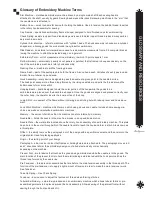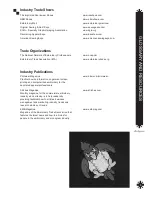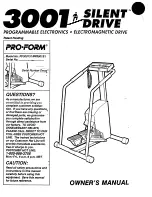
G
LO
SS
A
R
Y A
N
D R
ES
O
UR
C
ES
3
Pull Compensation – a degree of distortion built into a design by the digitizer to compensate for pull on the
fabric caused by the embroidery stitches.
Punching – conversion of artwork into a series of commands to be read by an embroidery machine’s com-
puter. Derived from an early method of machine embroidery in which part of the machine, the
automat, reads paper tapes or Jacquards punched with holes representing stitches, pantograph
movements and other commands.
Registration – correct registration is achieved when all stitches and design elements line up correctly.
Rotary Hook Assembly – holds the bobbin case in the machine and plays a vital role in stitch formation. Mak-
ing two complete rotations for each stitch, its point meets a loop of top thread at a precisely-timed moment
and distance (gap) to form a stitch.
Running Stitch
– consists of one stitch between two points. Used for outlining and fine detail. Also known as a
walk stitch.
SPI – stitches per inch; system for measuring density or the amount of satin stitches in an inch of
embroidery.
SPM – stitches per minute; system for measuring the running speed of an embroidery machine.
Satin Stitch – formed by closely arranged zigzag stitches. Can be laid down at any angle and with
varying stitch lengths. Adapted from the blatt stitch used in schiffli embroidery. See Blatt Stitch.
Scaling – ability within one design program to enlarge or reduce a design. In expanded format, most scaling
is limited to 10 percent to 20 percent because the stitch count remains constant despite final design size. In
condensed or outline formats, on the other hand, scale changes may be more dramatic because stitch count
and density may be varied.
Scanning – scanners convert designs into a computer format, allowing the digitizer to use even the most
primitive of artwork without recreating the design.
Short Stitch – a digitizing technique that places shorter stitches in curves and corners to avoid
unnecessary bulky build-up of stitches.
Specialty Fill
– a fill stitch capability that produces a fill with a “relief” or motif design within the
fill-stitch area.
Stiehl Stitch
– closely placed satin zigzag stitches where the width of the column is consistent and is defined
by mid-line points.
Stitch Editing – digitizing feature that allows one or more stitches in a pattern to be deleted or altered.
Stock Designs – digitized generic embroidery designs that are readily available at a cost below that of
custom-digitized designs.
Tackle Twill – letters or numbers cut from polyester or rayon twill fabric that are commonly used for athletic
teams and organizations. Tackle twill appliqués attached to a garment have an adhesive backing that tacks
them in place; the edges of the appliqués are then zigzag stitched.
Tension – tautness of thread when forming stitches. Top thread tension, as well as bobbin thread
tension, needs to be set. Proper thread tension is achieved when about one-third of the thread showing on
the underside of the fabric on a column stitch is bobbin thread.
Thread
– fine cord of natural or synthetic material made from two or more filaments twisted together and used
for stitching.
Topping
– material hooped or placed on top of fabrics that have definable nap or surface texture, such as
corduroy and terry cloth, prior to embroidery. The topping compacts the wale or nap and holds the stitches
above it.
Trimming
– operation in the finishing process that involves trimming the reverse and top sides of the embroi
-
dery including jump stitches and backing.
Underlay Stitch – stitches laid down before other design elements to help stabilize stretchy fabrics and to tack
down high wales or naps on fabrics so the design’s details don’t get lost. May also be used to create such ef-
fects as crowned, flat or raised areas in the embroidery, depending on how they are laid down.
Verify – sample sew-out or print-out of a new embroidery design to make sure the pattern is correct.
Walk Stitch – See Running Stitch.
Summary of Contents for GS1501
Page 30: ...GETTING STARTED 28 ...
Page 31: ...GETTING STARTED 29 The Control Panel Display ...
Page 62: ...EMBROIDERY BASICS 28 Notes ...
Page 64: ...MACHINE BASICS 2 ...
Page 65: ...MACHINE BASICS 3 ...
Page 70: ...MACHINE BASICS 8 ...
Page 71: ...MACHINE BASICS 9 ...
Page 78: ...MACHINE BASICS 16 Notes ...




































